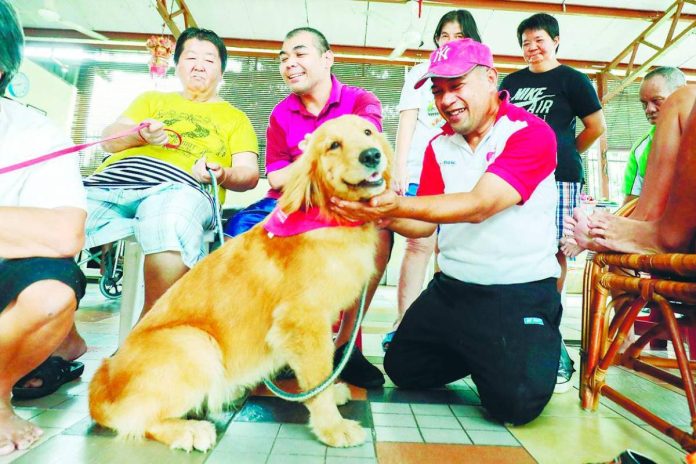OKAY hear me out: you are lying in a hospital bed, everything hurts, food tastes like cardboard dipped in sorrow, the nurse forgot your Milo ais again – and suddenly, a golden retriever waddles in wearing a tiny vest that says, “Therapy Dog on Duty”.
Tell me your blood pressure wouldn’t instantly stabilise? Tell me your soul wouldn’t do a little jig? Even your cranky roommate in the next bed, the one who keeps hogging the TV remote for endless sinetron marathons, would soften up when that tail starts wagging.
So here’s the million-ringgit question: Why aren’t we doing this everywhere? Hospitals, old folks’ homes, prisons and Jabatan Kebajikan Masyarakat. Because the heart knows what the spreadsheet can’t. Animal-assisted therapy isn’t some woo-woo TikTok trend where you chant affirmations to your houseplants; it is backed by science and common sense.
In the UK, therapy ponies trot into palliative care units, softening the hardest of days. In Japan, therapy dogs are enrolled in elder care, like it’s primary school – uniforms not included.
And here’s where it gets juicy: in Belgium, researchers found that cats can actually be trained and evaluated for Animal-Assisted Services (AAS). These aren’t your average “scratch-the-sofa” felines, they are carefully assessed for calmness, resilience and friendliness – so Mr Whiskers is not just adorable, he is scientifically verified.
Over Singapore, Thye Hua Kwan Hospital in Ang Mo Kio runs a cat-assisted therapy programme. Volunteers bring therapy cats to visit patients, giving them companionship and a reason to smile in between medical routines.
And in the Czech Republic and Slovakia, therapy cats have been part of “visiting services” for years – turning up in hospitals, children’s homes and elder care facilities.
Picture an old folks’ home in Hustopece where a therapy cat strolls in – suddenly the bingo hall feels less like purgatory and more like a family gathering.
So yes, therapy cats are clocking in for duty around the world. And imagine baring your soul while one lounges nearby, blinking slowly like it’s heard it all before – and honestly, it has. Healing served with judgement on the side.
Let’s go all in
Why not have dedicated hospitals or care centres that offer animal therapy as part of their treatment options? Like, give me the choice-lah.
You’re comparing ward A – sterile, echoey, smells like Dettol and regret – versus ward B – sunshine, flowers and a certified therapy cat called Datin Meow-Meow who naps on your lap – as part of your recovery plan.
You think I won’t sign that consent form twice, maybe even laminate it and frame it?
Call it PAWSpital or Fur-st Care Medical Centre. Put it on billboards. Offer it as a specialised centre where animal therapy isn’t treated like a side hobby (“eh, suka-suka bawa kucing masuk ward”) but as part of the official healing model. Integrated, respected and stamped with ISO certification if you must.
Imagine recovering from surgery and flipping through the hospital brochure. “Would you like acupuncture, aromatherapy or a one-hour cuddle session with Mr Fluffy?” What kind of monster would say no to Mr Fluffy? Even Darth Vader would pull off his helmet for that.
Old folks’ homes
Aunty Maimunah hasn’t had a proper hug since 2004. Her bones ache, her joints creak and the highlight of her week is Bingo night, which she keeps losing to Uncle Siva, who definitely cheats. But then a kitten curls up beside her, purring like a tiny motorbike and suddenly she’s stroking it like it’s her firstborn.
That is exactly what’s happening in parts of Europe and Singapore, where therapy cats are already part of elder care programmes. The cats don’t just sit pretty; they spark memory recall, reduce loneliness and make life worth a bit more than just counting the days.
That’s comfort money can’t buy. That’s dignity returned.
Prisons
Yes, controversial. Now, before you start composing a Facebook rant in all caps, you have to know that inmates who participate in animal care programmes often show reduced aggression, increased empathy and better post-release adjustment. Because you can’t stomp around like a gangster and still be bottle-feeding a bunny. It absolutely ruins the bad- boy aesthetic.
And look at Slovakia, where therapy cats and dogs are part of visiting services even in correctional or institutional settings. If Europe can trust prisoners with a cat, surely we can figure it out.
Mental health hospitals
Right now, many rely on medicines, overworked psychiatrists and therapy appointments that get rescheduled six times because of “doktor ada conference”. But imagine walking into a session where a trained Labrador is snoozing under your chair, tail occasionally thumping against the floor.
Or – and this is real – you are in Belgium, where cats in AAS have been used in mental health settings. These animals create a safer, softer environment to open up. Suddenly, it feels less like you’re about to be dissected and more like someone actually cares.
But allergies! Hygiene! Cultural sensitivities! Relax. Nobody is suggesting we turn every ward into a petting zoo. That is why the solution is dedicated centres and opt-in wards. Trained animals, strict hygiene standards and clearly defined pet-free zones.
You can even colour-code the floors – blue for general, pink for paediatrics and orange for paw patrol. And nobody is forcing a rabbit into the ICU-lah. Don’t be dramatic.
If we Malaysians can invent contactless payment for nasi lemak, create halal- certified skincare and host international durian expos that stink up half the city, we can figure out how to run a clean, respectful, culturally sensitive animal therapy facility.
Final bark, meow and squawk
This is bigger than just cute animals. This is about healing that acknowledges our humanity. Some pain lives in the body but some pain needs a tail wag, a head nudge or a soft purr to say you are not alone.
So let’s move past the red tape, the budget drama and the endless committee meetings where someone always asks, “but who will feed the hamster?”
Give patients the choice. Create dedicated therapy centres and let people decide whether they want sterile silence or fur-covered comfort. And to those in charge of policies and purse strings – don’t wait until a menteri’s cat needs therapy before approving this.
The people are ready. The animals are ready. Now, all we need is a system to catch up.
Sekian, makcik signing off – with a cat on my lap, a dog in my dreams and one eyebrow permanently raised at the policymakers.
Azura Abas is the associate editor of theSun. Comments: letters@thesundaily.com







